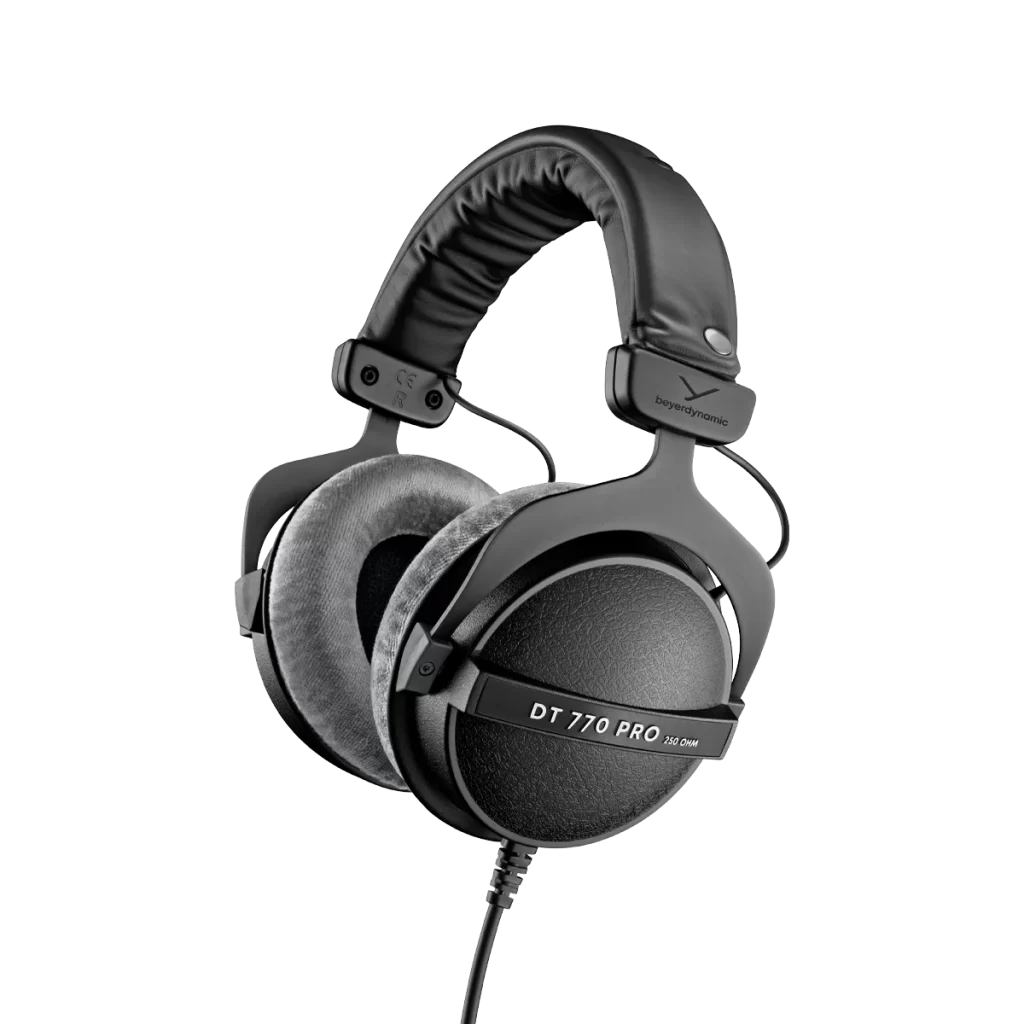Beyerdynamic DT 770 Pro and Its Competitors
Introduction
When it comes to professional studio headphones, the Beyerdynamic DT 770 Pro is a legendary name that has stood the test of time. Known for its exceptional sound quality, durability, and comfort, it has become a staple in recording studios and among audiophiles. However, the market is filled with worthy competitors, each offering unique features and performance. In this TOP3 script, we’ll dive into the Beyerdynamic DT 770 Pro and compare it with two of its strongest rivals: the Audio-Technica ATH-M50X and the AKG K371. We’ll explore the pros and cons of each model to help you make an informed decision.
1. Beyerdynamic DT 770 Pro
Overview
The Beyerdynamic DT 770 Pro is a closed-back studio headphone designed for professional use. It’s renowned for its robust build, excellent sound isolation, and versatile sound profile. Available in 32, 80, and 250-ohm versions, it caters to a wide range of users, from casual listeners to professional audio engineers.
Pros
- Sound Quality: The DT 770 Pro delivers a balanced sound signature with punchy bass, clear mids, and smooth highs. Its wide frequency response (5–35,000 Hz) ensures accurate audio reproduction, making it ideal for critical listening and studio work.
- Build Quality: Built to last, the DT 770 Pro features a durable metal headband, replaceable ear pads, and a coiled cable. Its closed-back design also protects internal components from dust and debris.
- Comfort: The velour ear pads and adjustable headband provide a snug yet comfortable fit, suitable for long listening sessions. The 80-ohm version, in particular, is praised for its treble attenuation, which is gentle on sensitive ears.
- Versatility: With three impedance options, the DT 770 Pro can be used with a variety of devices, from smartphones to high-end amplifiers.
Cons
- Clamping Force: Some users find the clamping force too tight, which can cause discomfort during extended use.
- Non-Detachable Cable: Unlike some competitors, the DT 770 Pro’s cable is not detachable, which can be a drawback for users who prefer modular designs.
- Soundstage: Due to its closed-back design, the soundstage is less expansive compared to open-back headphones like the DT 990 Pro.
2. Audio-Technica ATH-M50X
Overview
The Audio-Technica ATH-M50X is a popular alternative to the DT 770 Pro, known for its exceptional sound quality and portability. It’s widely used in studios and by music enthusiasts for its accurate sound reproduction and foldable design.
Pros
- Sound Quality: The ATH-M50X offers a detailed and balanced sound profile, with tight bass, clear mids, and crisp highs. Its large-aperture drivers and rare earth magnets ensure high-fidelity audio reproduction.
- Portability: Unlike the DT 770 Pro, the ATH-M50X features 90-degree swiveling ear cups and a foldable design, making it easy to carry and store.
- Detachable Cable: The ATH-M50X comes with three detachable cables (straight and coiled), providing flexibility and convenience.
- Comfort: The circumaural ear pads and padded headband offer a comfortable fit, though some users may find the ear pads slightly smaller than those of the DT 770 Pro.
Cons
- Soundstage: Like the DT 770 Pro, the ATH-M50X has a relatively narrow soundstage due to its closed-back design.
- Bass Emphasis: While the bass is tight and controlled, it can be slightly overpowering for some users, especially in bass-heavy genres.
- Build Quality: Although durable, the ATH-M50X’s plastic construction feels less robust compared to the DT 770 Pro’s metal headband.

3. AKG K371
Overview
The AKG K371 is another strong competitor, offering a modern design and a sound profile tuned to the Harman curve, which is widely regarded as a benchmark for accurate sound reproduction.
Pros
- Sound Quality: The K371 delivers a neutral and balanced sound signature, with precise bass, clear mids, and detailed highs. Its adherence to the Harman curve makes it ideal for critical listening and mixing.
- Comfort: The lightweight design and plush ear pads ensure a comfortable fit, even during long sessions. The adjustable headband also provides a secure fit.
- Detachable Cable: Like the ATH-M50X, the K371 features a detachable cable, adding to its convenience and durability.
- Portability: The foldable design and included carrying case make the K371 a great option for on-the-go use.
Cons
- Build Quality: While functional, the K371’s plastic construction feels less premium compared to the DT 770 Pro and ATH-M50X.
- Sound Isolation: The K371’s closed-back design provides decent isolation, but it’s not as effective as the DT 770 Pro’s.
- Bass Roll-Off: Some users note a slight roll-off in the sub-bass frequencies, which may not satisfy bass enthusiasts.
Conclusion
The Beyerdynamic DT 770 Pro remains a top choice for studio professionals and audiophiles, thanks to its exceptional sound quality, durability, and comfort. However, the Audio-Technica ATH-M50X and AKG K371 offer compelling alternatives, each with its own strengths and weaknesses.
- Choose the DT 770 Pro if you prioritize robust build quality, versatile impedance options, and a balanced sound profile.
- Opt for the ATH-M50X if portability, detachable cables, and a slightly bass-forward sound are more important to you.
- Consider the AKG K371 if you value a neutral sound signature, lightweight design, and modern aesthetics.
Ultimately, the best choice depends on your specific needs and preferences. Whichever model you choose, you’re investing in a high-quality headphone that will elevate your audio experience.
This script provides a comprehensive comparison of the Beyerdynamic DT 770 Pro and its competitors, highlighting their pros and cons to help users make an informed decision.

